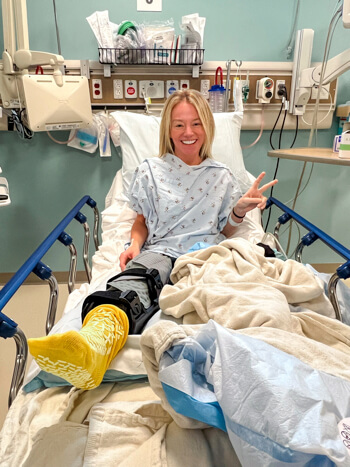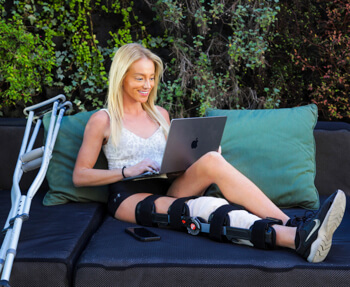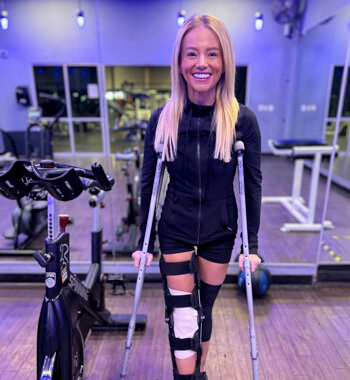Meniscus repair (meniscopexy) experience story
Navigating the First Month Post-Op
By Kirsten Alexis
Blog:
So, you’ve scheduled your knee surgery. What’s next?
If you’re anything like me, you probably have lots of questions about the procedure and recovery. You’ve probably heard a lot of different advice from lots of different people, and don’t quite know what to believe or expect. While every surgery is unique to the patient, I hope I can help you get a better understanding of the process and relieve any stress you might have.
Before Surgery
Depending on how much time you have to prepare before your surgery, I highly recommend prioritizing working on range of motion, strength, healthy dietary habits and a positive mindset during this time to set the tone.
Remember, your recovery results are completely dependent on the habits you create.
In my opinion, having a positive mindset is the most important thing to help your recovery journey go smoothly. Knowing that you are strong enough to handle anything that comes your way helps you take your power back, because you are in control of how you react. Cultivating gratitude for what you do have, and what you are capable of, will help you see the good when you feel down. Having hope will help you stay motivated to push through. It will help you create habits for success. It will help you to celebrate the little wins.
I had a few months before my operation, and I made sure to work on getting stronger every day, in order to be strong for my procedure and maximize my recovery. This included going to the gym to work on mobility and strength, making sure I had daily check-ins with my mental health, cooking nutritious meals, and doing research on how to maximize recovery.
I believe this set the tone to go in with a smile on the day of surgery.
Day One: Surgery
It’s finally here! The day you have been waiting for, and have probably had a mix of emotions about, ranging from anxiety to relief. I was definitely excited to get it done, as I had a lot of instability and pain from my injury, and I was looking forward to a better quality of life.
I made sure to schedule my surgery early, so I wouldn’t have to go too long without food throughout the day. Remember, you cannot eat or drink anything before the procedure, unless they prescribe you something. I got a carbohydrate drink that I had to drink two hours before, and that was all I could have.
When you get to the hospital, they will check you in, go over the procedure and answer any questions you might have. You will then be given an IV and soon be sent off to the OR, where you will have a nice nap from the anesthesia. My procedure only took about an hour.
After you wake up from the procedure, you will notice a large brace on your leg. It seems heavy, but it’s meant to keep you completely stable as you heal.
They will give you instructions for the next two weeks, and it is very important that you follow them. It can be hard to have that much down time, but it’s important so your knee can heal properly.
I recommend having an ice machine to use, as it drastically cut the swelling down. Elevate your leg, and sleep on your back. Make sure to stay hydrated, eat well, and to avoid weight-bearing as much as possible. Prioritize rest as much as you can; you might even sleep for most of this day. This will help set the tone for the next few weeks. You will get a lot more energy as you go, so making sure to schedule time for rest is beneficial.
And most importantly: have a positive mindset. To help, I recommend finding a hobby or activity that can help pass the time and help you stay mindful. Having a journal where you can write and draw helps a lot. It puts your mind into a nice flow state, and helps let the negative energy go.

The First Week
This is the most difficult week, as you’ll be adjusting to life in the traction brace and using your crutches almost everywhere. You will most likely still be tired from your procedure, which is ok because rest is your number one priority.
Make sure to follow your surgeon’s instructions as directed to ensure you can get the best possible outcome. I was instructed to keep my leg in the traction brace and to not put any weight on it for the first 2 weeks. I was also instructed to not submerge my leg for that period of time because of the sutures. During this time, I was told that it is extremely important to elevate the leg and apply ice. I was given an ice machine with an attached leg wrap and port at the hospital, and it was an absolute game-changer. You should apply ice a few times a day to help decrease swelling.
As for movement, during the first week you won’t have much. You can use your crutches when you need to be mobile, but your leg should be kept off the ground as much as possible. When you are seated, you can do light range of motion movements such as quad activators and calf
pumps. Please consult your doctor before doing them, as these were given to me according to my procedure.
For me, the scariest parts of week one were trying the stairs and shower for the first time. I was super cautious and moved slowly during each activity, and realized most of the problems were in my head. That said, things can go wrong, so make sure to always hold onto a railing or something stable to help you get stable.
Remember to take it easy. It might be boring, but your knee needs this time to recover. Trust the healing process. What helped me was taking up activities such as writing blogs, drawing on my tablet and creating content about the healing process.
If you make it fun, the journey won’t seem as difficult.
Week Two
The second week is very similar to the first, as you are still in the rehabilitation phase. You should ideally see a decrease in the swelling around your leg at this time from the elevation, rest and icing habits you created.
At the end of the two week period, you will see your surgeon to evaluate progress and get your stitches out. Finally! Those things start to itch.
Continue to avoid weight bearing and other activities that might stress the knee. If you’re anything like me, you have four more weeks of wearing the brace and using crutches, although each week you will see a lot more strength and progress. Continue to ice the knee, and to keep it elevated when you can. Continue the knee slide exercises to encourage more flexion and extension. You will notice that flexing the knee is difficult in a brace, and that’s ok. You will work on that in physical therapy after it’s removed.
Side note: I am still having some trouble flexing my knee after my brace was removed. Trust the process, and keep going. Your recovery is your own, so be your personal best.
Continue creating healthy habits and celebrating little milestones. Remember to trust the process and use this time wisely. Your healing depends on it.

Week Three
During this time you will start to feel a lot stronger, and more comfortable moving around with your brace and crutches. Also, if you were given six weeks of recovery for the meniscus repair surgery like I was, you’re at the halfway point of the initial recovery phase! That’s definitely something to be proud of!
You will also be working more on your range of motion, most likely continuing your work in extension and flexion with heel slides, quad activators and calf pumps. Flexion was definitely the hardest part for me, which is quite common because of the traction brace.
You will still want to be extremely mindful of weight bearing, although you will probably be advised to put a bit of weight on it while using crutches to get you ready to start really walking again come week six.
At this point you should be able to use the stairs with your crutches and handrail assist. Being mobile is a lot easier now that a lot of the swelling is down and stitches are out!
Make sure to ask your doctor and physical therapist which exercises are right for you. Keep up the healthy diet and positive spirits; you’re so close!
Week Four
This week is very similar to week four, but you will probably be feeling even more strong and energized. By now, your workouts will be a part of your routine, and you’re probably so ready to get out of the brace!
Keep up the range of motion workouts. These are so important to continue. Do these a multiple times a day to keep the leg moving. It can be hard to do, and don’t get discouraged if some days are harder than others. Take it easy and rest those days. Give yourself grace. Use ice and elevate your leg, and try again the next.
At this point I was using the pool to help me with my range of motion, as it is super low impact and easier to move around. Again, ask your doctor to see what is recommended. But, if you can, I highly recommend using the pool. Be very careful getting in and out!
And of course, stay positive and balanced!

Going Forward
Congrats, you’ve made it to a month of recovery! Although it’s far from over, you should be super happy for all of the progress you have made and the tone you have set for success.
At this point, you might have a few more weeks of the brace and crutches. Keep going. The six week mark, at least for me and my procedure, was when things definitely got more intense.
After you get your post-op evaluation, you will be sent to physical therapy to work on strength, endurance, range of motion and overall improvements in your performance. You will be advised to put in the work every day. And I recommend that you do. Make it a habit to go to the gym, or work out at home, with the advised exercises everyday. Make it fun. Set challenges for yourself.
See the long term, but celebrate daily achievements. Don’t get frustrated with setbacks. Stay positive.
You will get there!
